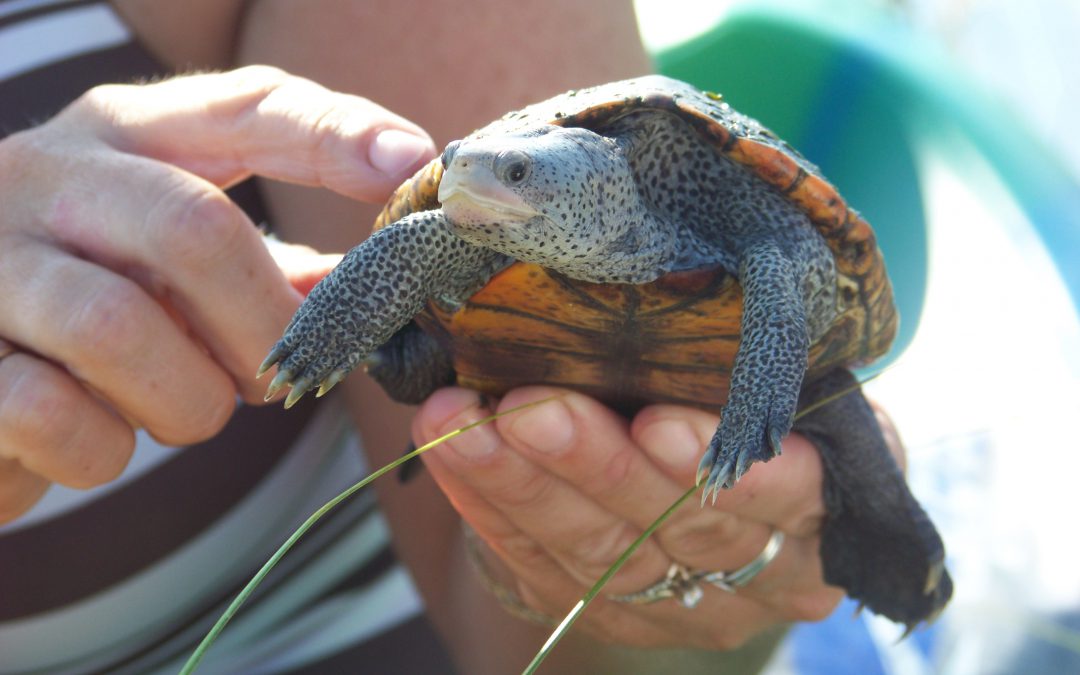
by Rick O'Connor | Dec 22, 2021
2021 Panhandle Terrapin Project Survey Report
Rick O’Connor, Florida Sea Grant, University of Florida / IFAS Extension, Escambia County
SITUATION
The diamondback terrapin (Malaclemys terrapin) is the only resident brackish water turtle in the United States. Ranging from Cape Cod Massachusetts to Brownsville Texas, this turtle is most often found in the salt marsh and mangrove habitats within this range.
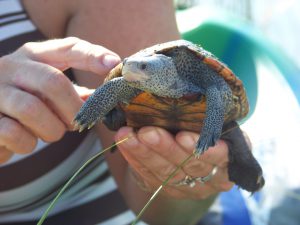
The light colored skin and dark markings are pretty unique to the terrapin.
Photo: Molly O’Connor
Terrapins are medium sized members of the Emydidae family, which includes the cooters, sliders, and box turtles. The carapace length of the larger females is about 10 inches, and she will weigh on average about 20 ounces. Males are smaller, 5-6 inches carapace and about 10 ounces. They are beautifully marked turtles having lighter skin with darker spots or bars. The carapace can have beautiful markings of spots and swirls, many times a brilliant orange in color. Because of this they are popular in the pet trade and illegal pouching is a problem across their range.
There are seven subspecies within this range.
- The northern terrapin ( t. terrapin) can be found from Massachusetts to the Chesapeake Bay area.
- The Carolina terrapin ( t. centrata) is found from the Chesapeake Bay area to the Daytona Beach area of Florida.
- The Florida east coast terrapin ( t. tequesta) is found from the Daytona Beach area to Miami-Dade County.
- The mangrove terrapin ( t. rhizophorarum) is found in the Florida Keys and along the Gulf coast to the Ten Thousand Islands area.
- The ornate terrapin ( t. macrospilota) can be found from the Ten Thousand Island area to Choctawhatchee Bay in the Florida panhandle.
- The Mississippi terrapin ( t. pileata) is found from Choctawhatchee Bay to the Louisiana/Texas state line.
- The Texas terrapin ( t. littoralis) is found along the coast of Texas.
The animal is quite well known in the Chesapeake Bay area where it was harvested in the 19th century as a food source. The popularity of “turtle soup” increased when President Lincoln included it as a local course for state dinners at the White House. The popularity increased the harvest to a point where terrapin farms began to supply the demand, many of these farms were in the south. Eventually the price became too high, and the popularity of the dish waned. At that point research into the animal began in earnest to assess how the commercial harvest had impacted the population. Much of this work was conducted in the early part of the 20th century. By the mid-20th century, a wired crab pot was developed for the harvest of blue crab, a popular fishery in the Chesapeake. Terrapins have a habitat of entering these crab pots and drowning. So, a new threat had emerged. About the same time the automobile was becoming more popular, bridges were being built to connect to barrier islands, and other locations, humans had not visited much before. This activity increased the number of nest predators for terrapins, raccoons being one of the larger problems.
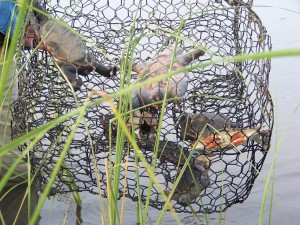
Terrapins in a derelict crab trap (photo: Molly O’Connor)
All of these issues led to more research on terrapin biology and ecology. However, there was one region within their range that very little was known – the Florida panhandle. There were no scientific studies conducted in this part of their range and even their existence there was questioned.
REPSONSE
In response to the question of existence in the Florida panhandle, the Florida Turtle Conservation Trust and the Florida Diamondback Terrapin Working Group, reached out to the Institute of Coastal and Marine Studies (a high school marine science program in Escambia County, Florida). The objective was to have them conduct surveys in suitable terrapin habitat indicating presence/absence of terrapins between Escambia and Franklin Counties. Those surveys began in 2005 and by 2010 had been conducted in all six counties with at least one verified record in each of the six counties (Escambia, Santa Rosa, Okaloosa, Walton, Bay, and Gulf). Terrapins did exist there.
Beginning in 2008 the team began to assess population status. Funding for mark/recapture was not available but a method of assessing relative abundance was being used in Mississippi and was chosen for the Florida panhandle. The method had made several assumptions –
- Each mature female nests every nesting season
- Each nesting female will lay more than one clutch each season but would not lay more than one within a 16-day period.
- The team had identified all terrapin nesting beaches in the region.
Based on this method, surveys were broken into 16-day intervals beginning April 1 and ending on July 1 (peak nesting period). Each track, or depredated nest, was counted and all sign of the track or nest removed so that it would not be recounted within that 16-day period. Each track would then represent a different female and over time the number of nesting females could be determined. Going on the argument that the sex ratio was 1:1 a relative abundance of adult terrapins could be determined. A study conducted in the Big Bend area of Florida by Suarez (Suarez, 2015) suggested the sex ratio was 1:3 in favor of males. A more recent study from the eastern panhandle conducted by Catizone (unpublished) suggests a 1:5 ratio in favor of males. Based on this we could develop a range of relative abundance from 1:1 to 1:5.
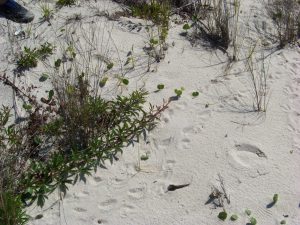
Note the track on this beach.
Photo: Rick O’Connor
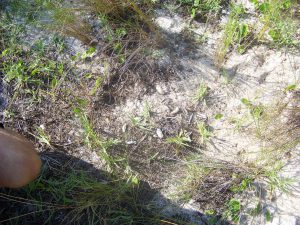
Egg shells indicate a depredated nest.
Photo: Rick O’Connor
Another metric used to measure relative abundance was a 30-minute head count. The team would sit in kayaks within the ponds where adults resided and count the number of heads in that time period. Again, this does not indicate a population but a relative abundance within that location.
Finally, in 2008 the team began to deploy modified crab traps to capture terrapins for a potential mark/recapture study, marking using a scute notching method. The traps were modified so that a captured terrapin would be able to surface and breath. These traps were set in potential adult residing locations for a five-day period beginning on a Monday and ending on a Friday.
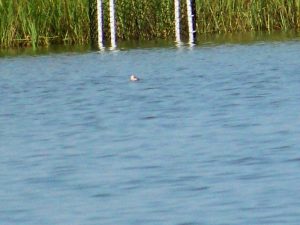
A terrapin swimming near but not entering a modified crab trap.
Photo: Molly O’Connor
The focus of the relative abundance and trapping portions of the project were Escambia and Santa Rosa Counties due to the fact the team resided there.
In 2012, the author left the marine academy and joined Florida Sea Grant. This project was not a high priority in the job description and effort on this waned until no surveys were conducted in 2014. However, in 2015 the author established a citizen science program to continue these surveys and they have done so since. The focus of those surveys has been frequency of occurrence (FOO – the number of surveys where either terrapins, or terrapin sign have occurred) and continuing the relative abundance data collection.
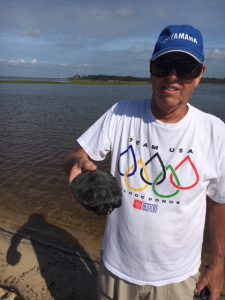
Citizen scientists have been crucial for the success of this project.
Photo: Rick O’Connor
In 2018 the U.S. Geological Survey joined the team. One member of USGS began coordinating citizen science work in the eastern panhandle (Bay, Gulf, and Franklin Counties as well as conducting research in the Gulf County area), and the author began coordinating citizen science work in the western panhandle (Escambia, Santa Rosa, Okaloosa, and Walton Counties). With USGS help some tagging has begun with both PIT and satellite tags.
RESULTS
The 2021 results are from the western panhandle portion of the project.
In the western panhandle during 2021, 263 surveys were conducted by 41 trained volunteers who logged 1832 hours. These surveys occurred in Escambia, Santa Rosa, and Okaloosa Counties. Surveys were conducted at known nesting areas with some occurring at potential new nesting sites. The number of surveys where either terrapins, or terrapin sign, were encountered was 52. This is a frequency of occurrence (FOO) of 20% of the surveys an encounter occurred. The breakdown by county is below.
2021 Data from the Western Panhandle
| County |
# of sites surveyed |
# of surveys |
FOO |
# of heads seen |
Nesting detected |
Relative abundance |
| Escambia |
8 |
86 |
.02 |
1 |
Yes |
8-24 terrapins |
| Santa Rosa |
2 |
79 |
.11 |
0 |
Yes |
4-12 terrapins
2-6 terrapins |
| Okaloosa |
5 |
98 |
.42 |
357 |
Yes |
20-70 terrapins
4-10 terrapins |
| TOTAL |
15 |
263 |
.20 |
358 |
|
|
Three of the eight sites surveyed in Escambia County were known nesting beaches, but evidence of nesting was only found at one. The other five locations were potential nesting sites, but no evidence of nesting was found. Based on these surveys, nesting activity declined in 2021.
Both sites surveyed in Santa Rosa County were known nesting beaches and nesting was detected at both. One site has long term data that, based on this year’s surveys, suggest a decline in relative abundance.
One of the five sites in Okaloosa was a known nesting site. However, evidence of nesting at a additional site was found. An encounter of some kind was logged at four of the five sites surveyed. All of these are relatively new survey sites to the project and relative abundance data is minimal. However, based on these data, the relative abundance is quite high.
Data from 2007 – 2021 for all sites
| County |
# of sites surveyed |
# of surveys |
FOO |
# of nesting beaches found |
| Escambia |
22 |
291 |
.11 |
4 |
| Santa Rosa |
13 |
441 |
.32 |
2 |
| Okaloosa |
12 |
123 |
.36 |
2 |
| Walton |
3 |
4 |
.25 |
0 |
| TOTAL |
50 |
859 |
.25 |
8 |
Since the beginning of the project 859 surveys have been conducted in the four counties of the western panhandle and terrapins have been encountered 25% of the time. Of the 50 sites surveyed, 8 (16%) of those have found nesting activity.
Objective 1 has been completed. There are terrapins in the Florida panhandle.
Objective 2 – the relative abundance – is still not completely understood. There was a significant decrease in encounters when the citizen science project began in 2015.
The citizen science effort the FOO was much higher and increased annually. The citizen science effort began in 2015 and the FOO was much lower but increased annually as well. It is believed that the cause of this decline is ability for volunteers to find terrapins, terrapin heads, or evidence of nesting. It is believed the volunteers are getting better and that the data will eventually provide better information on terrapin abundance.
DISCUSSION
Objective 1 has been answered. There are terrapins in the Florida panhandle.
Objective 2 is still not understood. It is believed the higher FOO between 2007 and 2011 was probably due to the ability of the volunteers to detect terrapin or terrapin sign. So, it is not known at this time whether the relative abundance of these animals have declined in the western panhandle or not. As the volunteers get better, we will see over time how the numbers change.
The effort of mark/recapture using modified crab traps has not been very effective. Traps have been deployed with much effort at four sites with very little success. That portion of the project has been suspended while searching for a better method of capture.
At two of the long-term monitoring sites, the relative abundance data suggests a decline in terrapins at those locations. However, as mentioned, confidence in the relative abundance data needs to increase before any strong conclusions can be drawn. These data do suggest small populations at all locations, between 20-50 animals. The citizen science effort will continue, and we hope a more robust population study will follow.
ACKNOWLEDGEMENTS
The author would like to thank the students from the Institute of Coastal and Marine Studies at B.T. Washington High School for assistance developing and conducting the early portion of this project.
Tom Mann from the Mississippi Department of Wildlife for the protocol on relative abundance based on nesting activity.
George Heinrich (Florida Turtle Conservation Trust, Florida Diamondback Terrapin Working Group)
Dr. Joe Butler (University of North Florida, Florida Diamondback Terrapin Working Group)
Dr. Andy Coleman (Birmingham Audubon Society, Gulf Coast Diamondback Terrapin Working Group)
Dr. Thane Wibbels (University of Alabama Birmingham, Gulf Coast Diamondback Terrapin Working Group)
Dr. Ken Marion (University of Alabama Birmingham, Gulf Coast Diamondback Terrapin Working Group) for their assistance, guidance and advice on this project.
Dan Catizone (U.S. Geological Survey, University of Florida)
Dr. Margaret Lamont (U.S. Geological Survey)
for their assistance, guidance, advice, and supply support.
Bob Pitts (Gulf Islands National Seashore)
Bob Blais (Navarre Beach Sea Turtle Conservation Center)
Jeanna Kilpatrick (Choctawhatchee Basin Alliance)
for taking the lead as county volunteer coordinators as well as surveyors.
And the 40 plus volunteers who have logged thousands of hours surveying sites in the western panhandle. We could not have done this without you.
Submitted:
December 22, 2021.
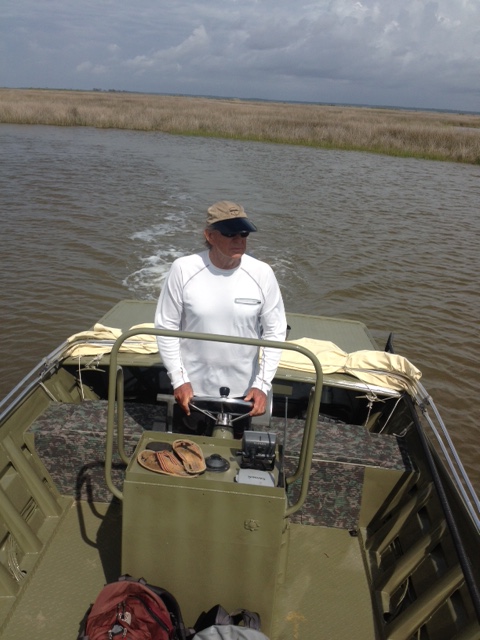
by Rick O'Connor | Dec 17, 2021
Recently I watched a documentary on TV entitled The Loneliest Whale; the search for 52. The title grabbed my attention and so, I checked it out.
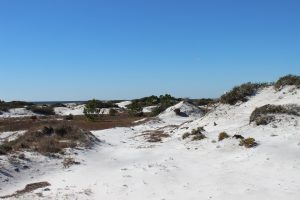
There are many forms of wildlife that are very hard to find in our area. But we continue to look.
Photo: Rick O’Connor
Seems a decade or so ago the U.S. Navy was doing SONAR work in the Pacific between Washington and Alaska and detected a strange sound coming in at 52 hertz. They had not herd this before and would continue to hear it in different locations around the northern Pacific. Their first concern was it was something new from the Russians, but when they showed the graphs and played the recording to a marine mammologist named Dr. Watkins, they found that it was most likely a “biological” – mostly likely a whale.
The problem was that Dr. Watkins had never heard whales calling at 52 hertz. If it was a whale, it was calling a lot – but no other whales were answering. Hence the name “the loneliest whale”. If it was a whale, and no others would talk to it, it was kind of sad. But who was this whale? What kind was it?
Word of the loneliest whale spread around the world and many humans made a connection to this animal, possibly because of their own disconnect with their own species. Stories and ballads were written, and people began to feel for the poor animal that apparently had no friends.
This story caught the attention of a documentary film maker who was interested in finding “52”, as the whale became known. He solicited the help of other marine mammologists; Dr. Watkins had died. According to those marine mammologists, this was going to be VERY difficult. It is hard enough to find just a pod of whales in the open Pacific, much less a specific pod with a specific individual. But they were excited about the challenge of finding this one animal, “52”, and off they went.
As I was watching this documentary it reminded me of my own search here near Pensacola. In 2005, I was asked by members of state turtle groups if I could search to see if diamondback terrapins lived in the western panhandle. This turtle’s range is from Cape Cod Massachusetts to Brownsville Texas, but there were no records from the Florida panhandle. Did the animal exist there? I was running the marine science program at Washington High School at the time and thought this would be a good project for us. So, we began.
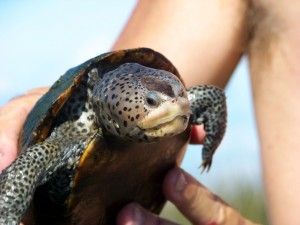
Mississippi Diamondback Terrapin (photo: Molly O’Connor)
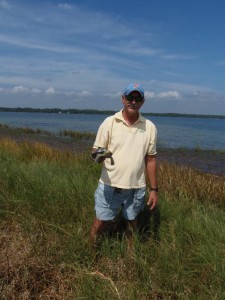
This small turtle can be held safely by grabbing it near the bridge area on each side.
Photo: Molly O’Connor
The students researched terrapin biology and ecology to determine the locations with the highest probability of finding, and we searched. I quickly found that the best time to search for terrapins was during nesting in May and June, and that the worst time to do a project with high school seniors was May and June. So, the project fell on my wife and me. For two years we searched all the “good spots” and found nothing. We placed “Wanted Poster’s” at boat ramps near the good spots with only calls about other species of turtles, not the terrapin.
Then one day in a call came in from a construction worker. Said he had seen the turtle we were looking for. For over a year we had been chasing “false calls” of terrapins. So, I was not overly excited thinking this would be another box turtle or slider. I asked a few questions about what he was looking at and he responded with “you’re the guy who put the wanted poster up correct? – well your turtle is standing next to the poster… it’s the same turtle”. Now I was excited. We did some surveys in that area and in 2007 saw our first terrapin! I can’t tell you how exciting it was. Two years of searching… at times thinking we might work on another project with a different species that actually exists… reading that the diamondback terrapin is like the Loch Ness monster – everyone talks about them, but no one has ever seen one. And there it was, a track in the sand and a head in the water. Yes Virginia… terrapins do exist in the Florida panhandle. The excitement of finding one was indescribable.
We were hooked. We now had to look in other counties in the panhandle, and yes, we found them. As I watched the program of the marine mammologists searching for “52” I could completely relate.
Today, as a marine educator with Florida Sea Grant, I train others how to do terrapin surveys and searches. I let them know how hard it is to find them and to not get disappointed. When they do see one, it will be a very exciting and fulfilling day. Our citizen science program has expanded to searching for other elusive creatures in our bay area. Bay scallops, which are all but gone however we do find evidence of their existence and spend time each year searching for them. In the five years we have been searching we have found only one live scallop, but we are sure they are there. We find their cleaned shells on public boat ramps – by the way, it is illegal to harvest bay scallops in the Pensacola Bay area. Another we are searching for is the nesting beaches of the horseshoe crabs. This is another animal that basically disappeared from our waters but are occasionally seen now. It is exciting to find one, but we are still after their nesting beaches and the chase is on.
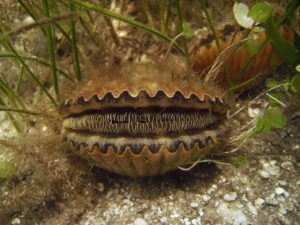
Bay Scallop Argopecten irradians
http://myfwc.com/fishing/saltwater/recreational/bay-scallops/
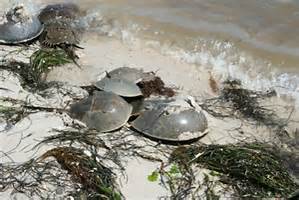
Horseshoe crabs breeding on the beach.
Photo: Florida Sea Grant
I love the challenge of searching for such creatures. If you do as well, we have a citizen science program that does so. You can just contact me at the Escambia County Extension Office to get on the training list, trainings occur in March, and we will get you out there searching. As for whether they found “52”, you will have to watch the program 😊
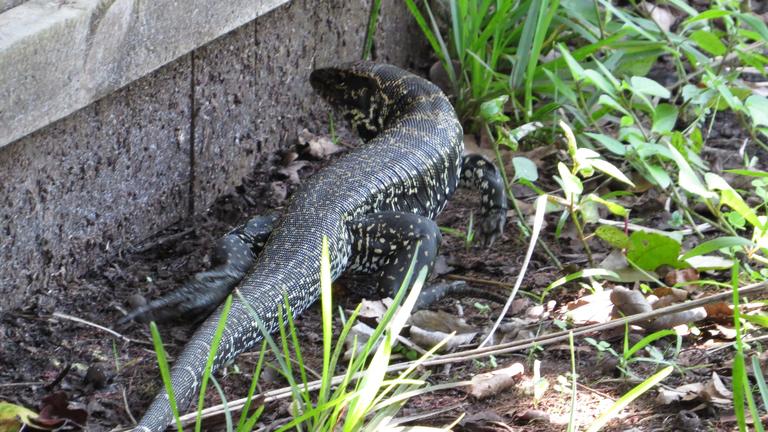
by Rick O'Connor | Dec 17, 2021
EDRR Invasive Species
Black and White Argentine Tegu
(Salvator merianae)

The Argentine Black and White Tegu.
Photo: EDDMapS.org
Define Invasive Species: must have all of the following –
- Is non-native to the area, in our case northwest Florida
- Introduced by humans, whether intentional or accidental
- Causing either an environmental or economic problem, possibly both
Define EDRR Species: Early Detection Rapid Response. These are species that are either –
- Not currently in the area, in our case the Six Rivers CISMA, but a potential threat
- In the area but in small numbers and could be eradicated
Native Range:
The Argentine Black and White Tegu is native to South America.
Introduction:
The tegu was introduced to Florida through the pet trade. Some animals either escaped or were released.
EDDMapS currently list 7,014 records of the Argentine Black and White Tegu in the U.S. 5,908 (84%) are from Miami-Dade County. There are 12 records from Georgia and one from Memphis Tennessee. The majority of records are from south Florida.
There are 12 records from the Florida panhandle and five within the Six Rivers CISMA. The only confirmed breeding pairs are in Miami-Dade, Hillsborough, and Charlotte counties in Florida.
Description:
Tegus are long black and white banded lizards that can reach four feet in length. They prefer high dry sandy habitats but can be found in a variety of habitats including agricultural fields.
Issues and Impacts:
Basically… they eat everything. Being omnivores, stomach analysis indicates they will feed on fruits, vegetables, eggs, insects, and small animals. These animals include lizards, turtles, snakes, lizards, and small mammals. They feed primarily on ground dwelling creatures. A typical tegu clutch will have 35 eggs.
The consumption of fruits and vegetables can have a major impact on agricultural row crops throughout Florida. Their habit of consuming eggs would include the American alligator, the American crocodile, and the gopher tortoise – all protected species.
Records show the number of tegus trapped each year is growing, with over 1400 captured in 2019. This suggests the populations are increasing and new breeding colonies are probable. There are also records of the animal in north Florida and Georgia, suggesting they can tolerate the colder winters of those regions.
Management:
Management is currently with trapping. Both the Florida Fish and Wildlife Conservation Commission and their subcontracted trappers are currently the primary method of removing the animals. Researchers from the University of Florida as well as those mentioned above frequently conduct roadside surveys searching for these animals. We ask anyone who has seen a tegu to report it on the IveGotOne App found on the EDDMapS website – www.eddmaps.org – or the website itself, and call your local extension office.
For more information on this EDRR species, contact your local extension office.
References
Control of Invasive Tegus in Florida. The Croc Docs. https://crocdoc.ifas.ufl.edu/projects/Argentineblackandwhitetegus/
Harvey, R.G., Dalaba, J.R., Ketterlin, J., Roybal, A., Quinn, D., Mazzotti, F.J. 2021. Growth and Spread of the Argentine Black and White Tegu Population in Florida. University of Florida IFAS Electronic Data Information System. https://edis.ifas.ufl.edu/publication/UW482
Harvey, R.G., Mazzotti, F.J. 2015. The Argentine Black and White Tegu in South Florida; Population, Spread, and Containment. University of Florida IFAS Publication WEC360.
https://crocdoc.ifas.ufl.edu/publications/factsheets/tegufactsheet.pdf
Johnson, S.A., McGarrity, M. 2020. Florida Invader: Tegu Lizard. University of Florida Wildlife Ecology Conservation. WEC295. https://edis.ifas.ufl.edu/pdf/UW/UW34000.pdf
Early Detection and Distribution Mapping System (EDDMapS)
https://www.eddmaps.org/
Six Rivers CISMA
https://www.floridainvasives.org/sixrivers/
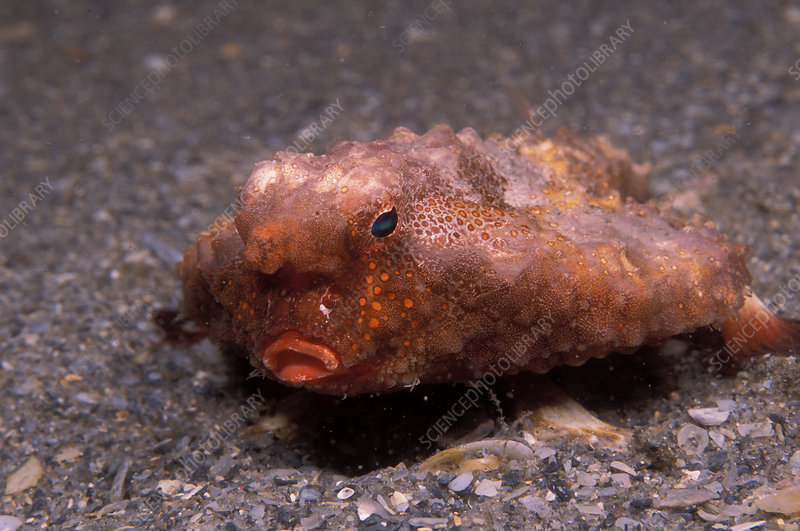
by Rick O'Connor | Dec 17, 2021
This is another one of those fish in this series that is not often seen but when you do see one you will ask “what is that?” – So, we will answer the question by including it here.
Like the frogfish we have already written about, batfish are described by Hoese and Moore1 as “grotesque” and they take it a step further by telling us all “ugly” fish (as they say) are grouped into what many call “dogfish”. As with the frogfish, I am not sure I would use the term grotesque, but they are strange looking.
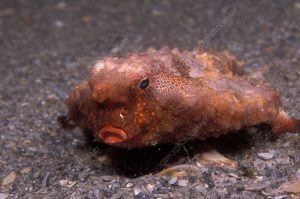
Juvenile Polka-Dot Batfish (Ogcocephalus radiatus) in the polluted intracoastal waterway in Palm Beach County, FL.
Photo: Science Photo Library
I have only seen a couple in my life. Hoese and Moore mention they are often brought up in shrimp trawls, and I have seen them while doing trawl surveys at Dauphin Island Sea Lab. I also found one while snorkeling along a seawall near Gulf Breeze FL. So, they are out there just not encountered as often, or as well known, or seen as frequently, as many other fish in the Gulf. Another reason to include this group here.
It is hard to describe what this fish looks like. They are, as they say, dorso-ventrally flattened – meaning from top to bottom, not side to side – like a stingray. They have two fins extending from parts of their body that sort of “stick out of the side” and appear to be like webbed feet with which they walk. Actually, there are these small, modified fins on the ventral side that are used to walk on the bottom – they are bottom dwelling (benthic) fish for sure. Like their relatives the frogfish they have a modified spine that is used like a fishing lure. Like the frogfish, the shape of that lure can be used to identify species. But unlike the frogfish the lure is located between their mouth (which near the bottom of the body and is very small) and a pointed rostrum that extends from the top of their head like a battering ram. This lure is extended to lure not fish swimming above, as with the frogfish, but small creatures in and on the sand. Because of this they do not call the lure an illicium but a esca. These are strange looking fish.
Hoese and Moore list four different species and indicate there are at least three others in the Gulf of Mexico. Most are associated with the continental shelf of the Gulf and not inland where we might see them snorkeling around. A couple of species are more associated the continental slope, which drops from the continental shelf to the deep sea. But the Polka-dot batfish (Ogocephalus cubifrons) is reported as being inshore and is the species I have encountered.
Many species are only described as being from the shelf of the Gulf of Mexico and no other oceans. Some of them are even more restricted to either the eastern or western Gulf. This all suggests that batfish do have biogeographic barriers of some sort restricting their dispersal. Being offshore benthic fish, your first guess would be substrate. Usually in those locations the temperature and salinities are pretty similar but the material on the bottom (rock, shell, sand, canyons, etc.) are not. However, several articles mention that batfish can be found over rocky or sandy bottom2,3,4 and the polka-dot batfish can be found in grassbeds as well2. So, I am not sure what the possible barrier is, but several do have a limited range. The east-west split could very well be the DeSoto Canyon off the coast of Pensacola.
All of that said, it is a very interesting group of fish that for one species you might encounter while out and about snorkeling or diving in the Florida panhandle.
References
1 Hoese, H.D., Moore, R.H. 1977. Fishes of the Gulf of Mexico; Texas, Louisiana, and Adjacent Waters. Texas A&M Press. College Station, TX. Pp. 327.
2 Ogocephalus cubifrons, Polka-dot batfish. 2017. Discover Fishes. Florida Museum of Natural History. https://www.floridamuseum.ufl.edu/discover-fish/species-profiles/ogcocephalus-cubifrons/.
3 The Red-lipped Batfish. 2014. Ashland Vertebrate Biology. Ashland University, Ohio. http://ashlandvertbio.blogspot.com/2014/12/the-red-lipped-batfish.html.
4 Cocos Batfish, Ogocephalus porrectus. 2015. Smithsonian Tropical Research Institute. https://biogeodb.stri.si.edu/sftep/en/thefishes/species/777.
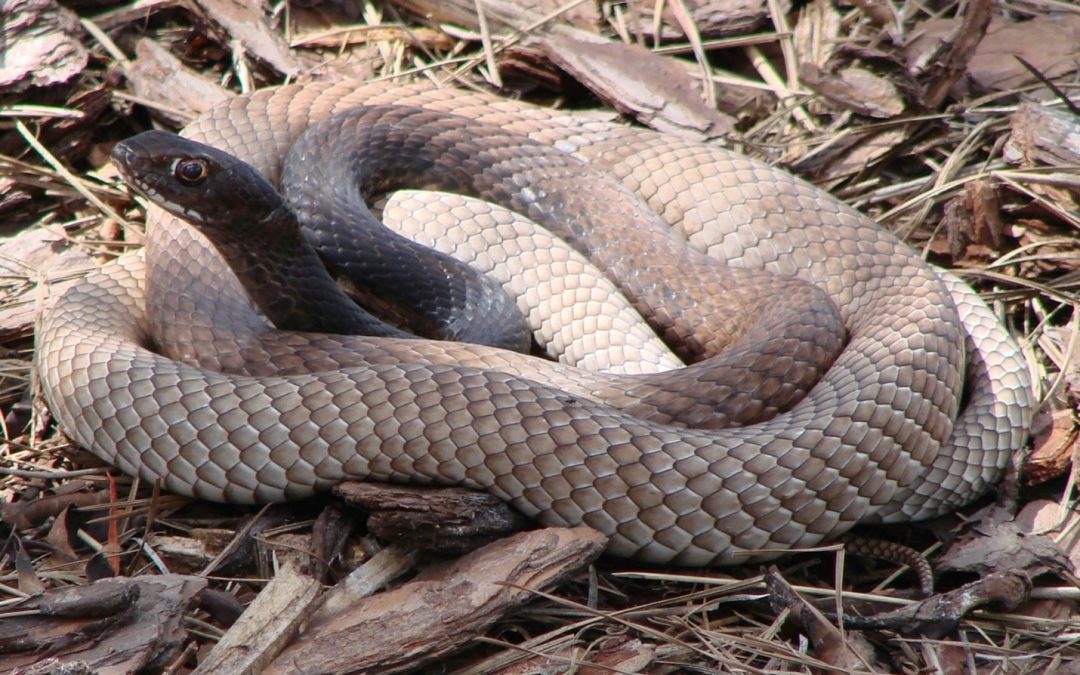
by Rick O'Connor | Dec 10, 2021
By Dr. Steve A. Johnson, Department of Wildlife Ecology & Conservation, University of Florida
As I was pondered writing about snakes for Panhandle Outdoors, an email notification appeared on my computer screen: “Snake in Pensacola Bay”. As a State Extension Specialist with the University of Florida’s Institute of Food and Agricultural Sciences I receive a lot of email requests to identify snakes and other reptiles. But the subject line of this message really got my attention because most of Florida’s approximately 50 species of native snakes are terrestrial, and with few exceptions, our aquatic snakes only occur in freshwater. Florida is home to one snake that lives in the marine environment, the Saltmarsh Watersnake (Nerodia clarkii), but they inhabit shorelines and rarely stray far from cover. And sea snakes are only found the Pacific Ocean basin—they do not naturally occur in the Gulf of Mexico.
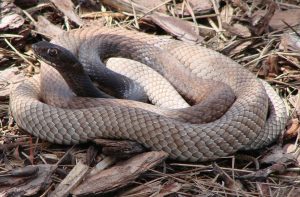
Eastern Coachwhips are long and thin, and most adults have a dark head and upper body. The rest of the body is tan or brown and the scale pattern on the tail resembles a braided bullwhip. Photo by Nancy West.
With anticipation I opened the email and viewed the attached images. To my surprise the snake seen by a fisherman who “came across a snake swimming out in the middle” of Pensacola Bay was an Eastern Coachwhip (Masticophis flagellum). In my almost 20 years with the University of Florida I’ve been emailed hundreds of times with requests to identify snakes. Although the coachwhip is a fairly common snake in Florida, its rarely the species I’m asked to identify. But I distinctly remember another email about 10 years ago from a gentleman in southeastern Florida who claimed he had killed a deadly Taipan snake, or at least something that looked to him like a Taipan. He told me he had lived in Florida for 30 years and knew how to identify snakes, but he had never seen a native snake that looked like this. There are three recognized species of Taipans, they are all native to Australia and are among the world’s most venomous land snakes. However, Florida is the global epicenter for introductions of non-native reptiles, due mainly to imports for the exotic pet reptile trade, so I did not immediately dismiss his assertion of Taipan, but I was highly suspect. Fortunately, the image attached to the email was not a Taipan. But unfortunately, it was an Eastern Coachwhip that he needlessly killed. Coachwhips are not venomous and are certainly not deadly of even dangerous, unless you are a lizard.
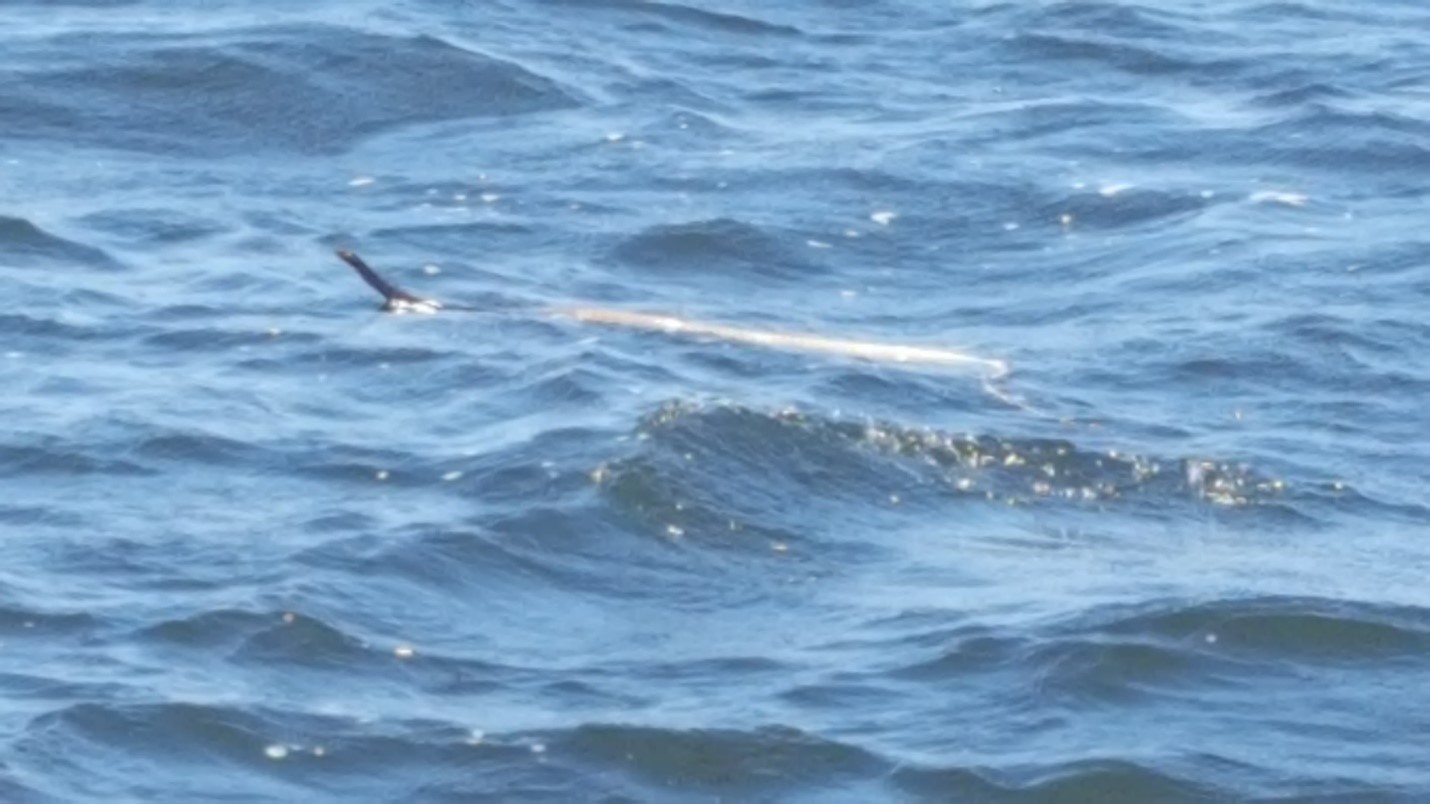
The dark head and upper body followed by a tan color allowed positive identification of this snake in Pensacola Bay as an Eastern Coachwhip. Photo by David Celko.
Coachwhip snakes are closely related to the Black Racer, the common “black snake” of the Southeast. Like racers, coachwhips are long, thin snakes with relatively large eyes. In fact, the Eastern Coachwhip is one of the longest native snakes in North America, reaching a maximum length of 8.5 feet, including the tail. The head and upper body of adult Eastern Coachwhips are usually dark brown or black, fading to brown or tan the rest of the length of their thin body. The scales on their tail resemble the braided pattern of a bullwhip, which is where they get their common name of coachwhip. Young Eastern Coachwhips are also tan colored, but they lack the dark head and upper body. The large eyes are especially obvious in young coachwhips.
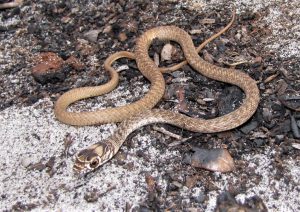
Juvenile Eastern Coachwhips are quite thin and have large eyes. They lack the dark-colored head and upper body of most adults. Photo by Dr. Steve A. Johnson, UF/IFAS.
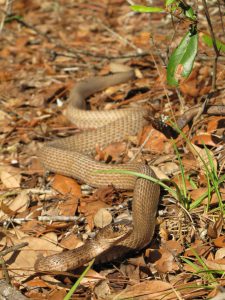
In northern peninsular Florida adult Eastern Coachwhips may lack a dark-colored head and upper body. Photo by Dr. Steve A. Johnson, UF/IFAS.
Eastern Coachwhips actively forage for lizards during the day, and they also eat small mammals, birds, frogs, and even small turtles. While hunting for prey they often move about with their head raised above the ground, visually searching for signs of movement. Eastern Coachwhips have a strong bite, which is how they subdue larger prey—they do no kill prey by constriction like do rat snakes. Coachwhips are fast snakes and can crawl more than 3.5 mph. When startled they often rapidly escape into a burrow or climb into a shrub or small tree. At night they shelter in burrows made mammals as well as the Gopher Tortoise.
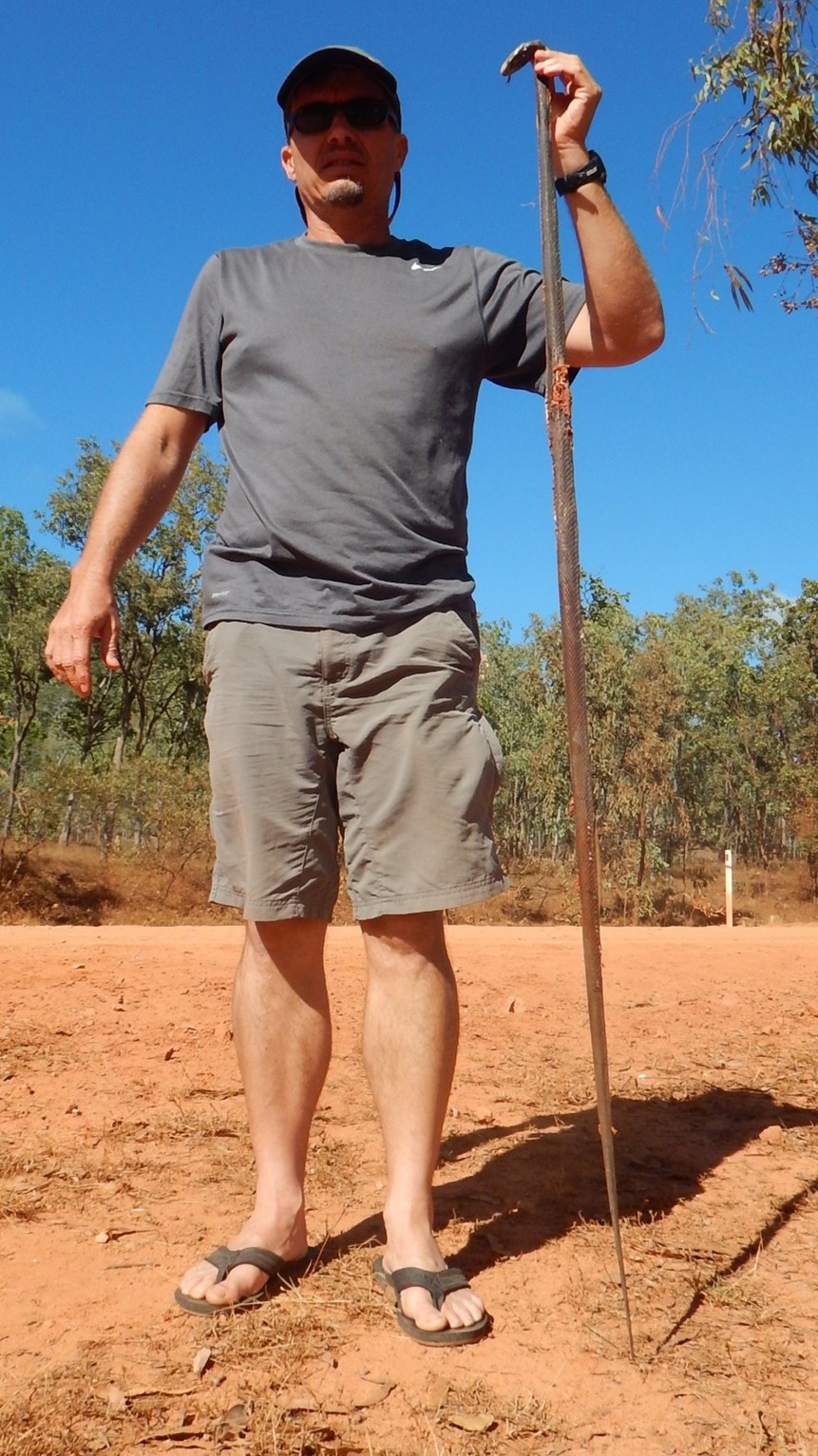
The author holding a (dead) highly venomous Taipan in far north Queensland, Australia. Even in very remote places, roads and vehicles are a source of snake mortality. The Taipan resembles the Eastern Coachwhip of Florida, but taipans only occur in Australia. Photo by Dr. Todd Campbell, University of Tampa.
Like all Florida’s snakes, Eastern Coachwhips are threatened by habitat loss and fragmentation by roads. Coachwhips move around a lot, and often get smashed by vehicles. So do the right thing and “give a snake a brake” the next time you see one attempting to cross a road. And certainly, never kill an Eastern Coachwhip on purpose as they are not venomous and don’t pose any danger to people or pets.






















